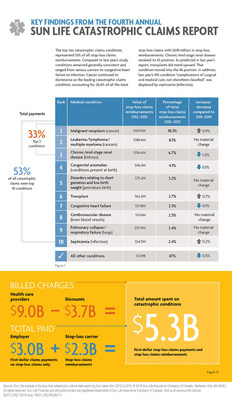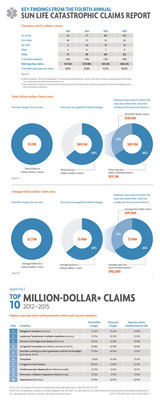WELLESLEY, Mass., July 11, 2016 /PRNewswire/ -- In its fourth annual Top Ten Catastrophic Claims Conditions report, Sun Life Financial U.S. brings insights to self-funded employers about critical factors impacting medical costs. The report compiles the costliest medical conditions covered by Sun Life stop-loss insurance from 2012 to 2015 and explores emerging trends to help brokers and self-funded employers understand and mitigate their risks.

During the four years of the study, billed charges from medical care providers totaled $9 billion. Self-insured employers paid just over half ($5.3 billion) of those billed charges after discounts were applied and received $2.3 billion in reimbursements through stop-loss protection.
The report shows that million-dollar-plus claims continue to trend up with an increase of 25% compared to last year. Severity continues to be a factor with less than 2% of million-dollar plus claimants (448) accounting for a disproportionate 18.5% of overall stop-loss claims reimbursements ($431.2 million).Over the four-year period, the average amount paid by an employer on a claim above $1 million was $1.45 million, which was reduced to $491,000 after applying the average stop-loss claim reimbursement ($962,000).
Cancer continues to dominate the top of the list (number one and number two) with $618 million in stop-loss reimbursements, accounting for more than one-quarter (26.6%) of total stop-loss claims. Of the various types of cancer identified in the report, breast cancer accounted for 13.6% of the total reimbursements for this condition. Cancer is also a leading million-dollar condition—it's in the number-two spot after premature infant and liveborn complications.
The report cites intravenous medications as a key driver of rising cancer costs and provides an analysis on the top twenty intravenous medications in 2015.
Chronic/end-stage renal disease (kidneys) held steady in the number-three spot on the list, accounting for over $369 million in combined first-dollar claims and stop-loss claims reimbursements. Although the average treatment cost for claims associated with kidney disease has gone down 21% over the last four years, the high incidence rate of the condition contributes to its ranking. One in three Americans are at risk for kidney disease, with diabetes and hypertension as leading causes.1 The report highlights how improvements in cost management and increased use of transplants might continue to reduce the costs associated with this condition over time.
As an upward trend to watch, transplants made the report in the number-six position, with a 65% increase in incidence from 2012 to 2015. In addition to the expanded use of transplants, the report cites an increase in organ donations and improved procedures (which can increase the pool of potential candidates) as contributing factors. Transplants represented over $62.2 million in stop-loss claims. Notably, there was a 79% increase in bone marrow/stem cell transplant costs and a 55% increase in associated pre- and post-transplant costs.
"More employers are self-funding their medical plans than ever before, and managing the rising cost of health care continues to be one of their central concerns," explained Brad Nieland, Vice President, Stop-Loss, Sun Life Financial U.S. "By highlighting the conditions that create catastrophic claims and providing insights into trends influencing high costs, we can help employers anticipate what they'll see when self-funding and raise awareness about the importance of cost-containment resources and stop-loss insurance."
This year, the report also takes into account how geographic location impacts the costs for medical care. The East South Central, Mid-Atlantic, and Pacific regions were the most expensive areas to experience a catastrophic condition, with costs above the national average (27%, 22%, and 19% respectively).
For more information, see the following:
- PDF of the full report: http://bit.ly/2016slfcatastrophicclaimsreport
- Infographic of catastrophic claims costs and the top ten conditions: http://bit.ly/2016slfcatastrophicclaimsinfographic
About Sun Life Stop-Loss
Sun Life is the number-one independent provider of stop-loss insurance in the United States.2 Stop-Loss insurance protects self-funded employers by limiting the risk associated with catastrophic claims. As of year-end 2015, 1,979 self-funded employers had stop-loss insurance with Sun Life, covering 5.2 million individuals.
About Sun Life Financial
Sun Life Financial is a leading international financial services organization providing a diverse range of protection and wealth products and services to individuals and corporate customers. Sun Life Financial has operations in a number of markets worldwide, including Canada, the United States, the United Kingdom, Ireland, Hong Kong, the Philippines, Japan, Indonesia, India, China, Australia, Singapore, Vietnam, Malaysia and Bermuda. Sun Life Financial Inc. trades on the Toronto (TSX), New York (NYSE) and Philippine (PSE) stock exchanges under the ticker symbol SLF. For more information, please visit www.sunlife.com.
In the United States, Sun Life Financial is one of the largest group benefits providers, serving more than 60,000 employers in small, medium, and large workplaces across the country. Sun Life's broad portfolio of products and services in the U.S. includes Disability and Absence Management, Life, Dental and Vision, Voluntary, and Stop-Loss insurance. This includes the acquisition of Assurant Employee Benefits in Q1 2016. For more information, please visit www.sunlife.com/us.
- National Kidney Foundation, "Fast Facts," referencing United States Renal Data System 2015 Annual Report and the Centers for Disease Control and Prevention, https://www.kidney.org/news/newsroom/factsheets/FastFacts. National Institute of Diabetes and Digestive and Kidney Disease, High Blood Pressure and Kidney Disease, http://www.niddk.nih.gov/health-information/health-topics/kidney-disease/high-blood-pressure-and-kidney-disease/Pages/facts.aspx.
- The number-one ranking is based on the 2014 year-end Sun Life Stop-Loss premium of $1.03 billion and on a Sun Life analysis of publicly available financial information and third-party market share data.
Media Contacts:
Amanda Gallo
Sun Life Financial
amanda.gallo@sunlife.com
781-446-1264

Photo - http://photos.prnewswire.com/prnh/20160710/388105-INFO
Photo - http://photos.prnewswire.com/prnh/20160710/388105-INFO
To view the original version on PR Newswire, visit:http://www.prnewswire.com/news-releases/top-ten-catastrophic-claims-conditions-report-explores-costliest-medical-conditions-and-emerging-trends-300296286.html
SOURCE Sun Life Financial U.S.